By Jeffrey A. Rendall; Photos By Kevin Gaydosh and Jeffrey A. Rendall
|
|
BETHESDA, MD – The Washington area’s Booz Allen Classic is on holiday this year. No, it’s not taking a season off, and it’s not going on vacation – to be played at some exotic alternative locale.
In a way, it’s almost going back to the future.
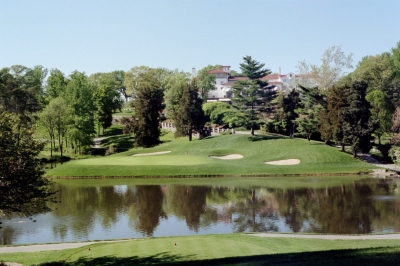 |
| Congressional's Blue Course closes with a 190-yard par three -- but there's little doubting it's still a spectacular finish. |
The Booz Allen’s headed ‘back’ to Congressional Country Club’s Blue Course if only for one year – something that’s generating a great deal of excitement for professional players and Capitol area golf enthusiasts alike. Some of the veteran Tour players remember playing there nineteen years ago when the tournament (then known as the Kemper Open) last made Congressional a regular Tour stop – and still more recall the 1997 US Open, which was played a week after the local stop was contested at TPC Avenel, just down the street from Congressional.
Due to planned renovations at Avenel, the tournament’s organizers asked Congressional’s membership if they’d host the tournament in 2005, and they enthusiastically agreed.
The players have also responded – and the 2005 Booz Allen Classic field will certainly be one of the season’s best, with eighteen out of the top twenty (in the world rankings) planning to be there.
So what is it about playing the event on Congressional’s Blue Course that’s getting everyone so juiced up? We’ll let local PGA Tour player (and The Player’s Champion) Fred Funk provide the answer: “When you go to Congressional Country Club, there’s a definite major championship atmosphere, because they’ve hosted several majors there. It’s just got that great look and feel like you’re playing somewhere very special.”
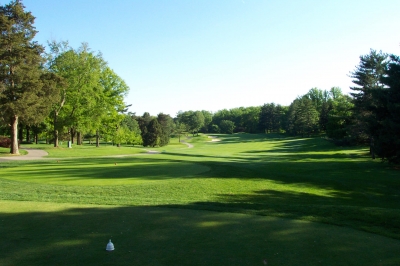 |
| Rees Jones says the par four fifth hole is one that's been lengthened since the 1997 US Open. From the tee, it looks like there's plenty of room -- but you're still going to need to be accurate. |
Funk continues, “You get a sense of it when you first drive in – just seeing the clubhouse and entranceway. There’s a certain aura around Congressional that not many clubs have. You get that same kind of special feeling when you’re arriving at Augusta National, or a place like Cypress Point. I get that feeling at Congressional, even though I’m from around there.”
So the venue makes a heck of a difference. But Funk also admitted that the 2005 Booz Allen’s place on the calendar doesn’t hurt, coming just one week before the US Open, set for play a few hundred miles down the interstate at Pinehurst in North Carolina. In contrast, last year’s tournament fell the week after the Open, and there was a considerably weaker field.
Adding still more luster to playing at Congressional is its future – the USGA tagged the Blue Course once again to host the 2011 US Open, and many players want to play it now, under tournament conditions, to see what it’ll be like in the days yet to come.
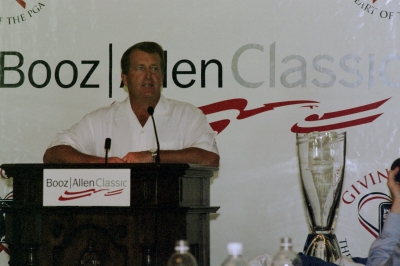 |
| Fred Funk speaks next to the 2005 Booz Allen trophy. There're 156 players in the field this year, yet no one would rather win it than Funk. |
The ‘Open Doctor,’ Golf Architect Rees Jones, thinks the 2011 Open is a big reason why a number of players want to play here in 2005. Jones did the upgrade work on the Blue Course (which his Dad, Robert Trent Jones had worked on) prior to its’ hosting of the ’97 Open, and will do some more work on the layout between now and 2011. You can tell he likes the Blue Course.
“I think Congressional (Blue) has some of the best championship greens in golf, because they effectively make the green contours into a hazard,” Jones said. “There are transitions in the surfaces, and if you’re a long way from the hole, you’re probably going to have to navigate some pretty severe slopes – like on the seventeenth hole, you’ve got to go up and down to reach the pin position on the peninsula. The pros don’t like doing that.”
“These types of greens are the hardest to putt – if you’re going down, you just get it started, and if you’re going up, you can get the feel of the stroke. But when you’ve got up and down transitions and rolls in the green, it’s hard to get that feel for the speed. It’s very, very effective in challenging the players. I think people forget how important green contours are in championship golf,” Jones said with a great deal of satisfaction.
Having challenged the Blue Course, I can see exactly what Jones is saying. Being on the putting surface doesn’t guarantee you a two-putt. And if you’re far enough away, you might be thinking ‘It’ll be good work just to three-putt from here.’
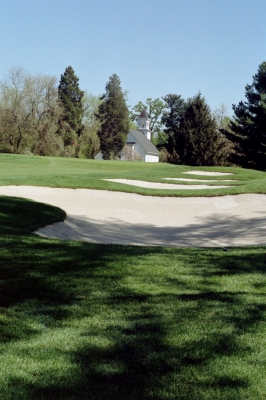 |
| The 579-yard, par five 15th hole is a three-shotter for most pros. Like all the holes on Congressional's Blue Course, there's something to see. |
At the ’97 US Open, Tiger Woods said during a pre-event interview that he would be using driver a lot off the tee, in hopes of hitting into the greens with shorter irons. Woods said the Congressional greens are such that, if you’re within ten or fifteen feet, you have a real good birdie opportunity – but if you’re forty or fifty feet away, there’s a chance you’ll three-putt.
As alluded to earlier, Jones upgraded the Blue Course in 1989. Gilded Age course architect Devereux Emmet originally designed what is now the Blue Course’s front nine, and Robert Trent Jones came in and finished the back nine (and re-modeled some of the holes on the front nine) prior to the 1964 US Open.
Jones describes what was done in the late-eighties: “I went in there to rebuild the greens, but once we started on that, we decided to re-address the bunkers, the fairways and the overall length of the course. It turned out that we basically built an entirely new golf course on an old routing. We weren’t exactly sure who’d done the routing on the original back nine, because they’d started construction before my Dad went in there. So I gave it a Robert Trent Jones routing.”
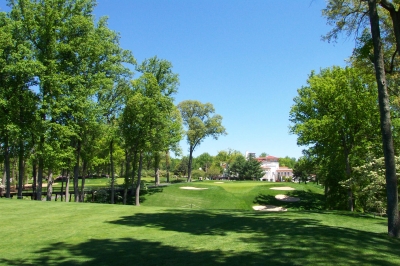 |
| At 602 yards, the par five 9th hole is the Blue's longest hole. And there's a great view of the clubhouse in the background, too. |
Part of the work involved eliminating blind shots.
“We re-graded a lot of the fairways for visibility, but also worked it so the holes flowed the way that they should. And you’ve got some pretty darn substantial par fours on the back nine, like sixteen – we re-graded that whole thing, made it a plateau. Before, the ball would just kick to the bottom of the slope (off the tee) – and it played very short. It really wasn’t a very good hole, and they didn’t even use it for the ’64 Open,” Jones said.
As far as the set-up for the 2005 Booz Allen Classic, it’ll probably be somewhat kinder and gentler than it was in the ’97 US Open, but not a whole lot.
Again, Jones serves as the expert on the differences. “I think if they’d played the Booz Allen immediately after the ’97 Open, they would’ve chosen some of the easier hole locations. But now that the ball’s going so far, I think the PGA Tour will actually tuck the flags, because they are hitting shorter clubs into the surfaces. The rough probably won’t be quite as high, and I’m not sure if they’ll get the greens’ speeds to what the USGA does for a US Open – but it’ll be a similar test.”
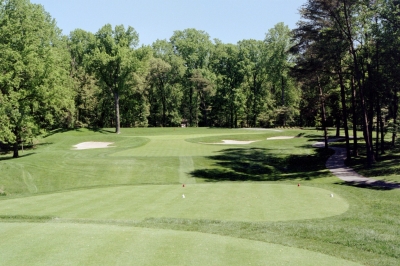 |
| It may look tame, but the green of the par three 12th hole protects par very well. Watch that pin location carefully, or you're going to have one of those 'transitional' putts that Rees Jones was talking about. |
Hence, you get what Funk said above – a major-type tournament without actually being a major. It’s just what the folks at Booz Allen Hamilton want to hear.
There will be some additional changes to the Blue Course prior to 2011 Open – Jones said they’re going to add length on several holes, a few bunkers, and the eighteenth hole (currently a par three) will be reversed and become the new tenth hole. That’ll leave the dramatic seventeenth hole to supply the tournament-closing excitement, which it’s more than capable of handling.
Just ask Tom Lehman what it’s like to face the tough seventeenth with the US Open on the line. Lehman put it in the water, and Ernie Els walked away with the trophy.
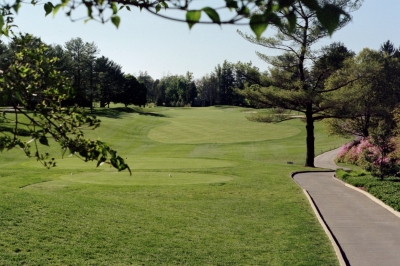 |
| Starting off on the 1st hole. At 402 yards, you'll probably have a short-iron in on your first link of the day. Be thankful. |
Els will be here again in 2005, and so will world number one (for now, at least) Vijay Singh, eternal crowd pleaser Phil Mickelson and fifth ranked (and defending US Open Champion) Retief Goosen. Other notables include Lehman, Sergio Garcia, Justin Leonard and last year’s champ, Australian Adam Scott.
The guy who won’t be here is Tiger Woods. Woods never plays the week before the US Open, and even the Booz Allen’s move to Congressional Country Club wasn’t enough to tempt him out of his annual majors-preparation routine.
Funk thinks it’s not fair to focus on who won’t be here. And that’s not just this year or this event – that’s every week on the PGA Tour: “Every year we have the major tournaments, but there are also a number of very special events that might not always get the date that they want and still get their strong fields.”
He continues, “Then you’ve got the other 80% of the schedule, the so-called ‘lesser field’ tournaments, and the media concentrates on who’s not there. That’s not really fair to those tournaments where a lot of the younger guys are playing. These guys are just unbelievable talents that I’ve seen coming up, these twenty-something players, and it’s ridiculous how far they hit it, and how fearless they are.”
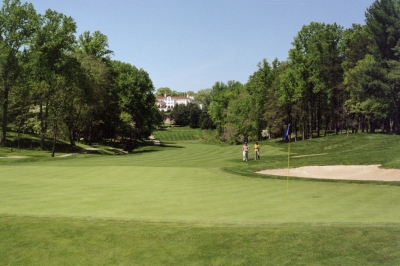 |
| One of the best views on the Blue Course, look back up the hill towards the clubhouse on the par five/four 10th hole. In 1997, they played it as a 507-yard par four. Ouch. |
“The people who run these tournaments work extremely hard to ensure their events are a success, and the charities in every city deserve the same attention, regardless of who’s playing and who’s not,” said Funk, who’s become quite a celebrity draw himself, after blooming late in his career.
In other words, the talent pool is deep on the PGA Tour, even if the ‘name dropping’ might not be as impressive at certain events, like our own Booz Allen Classic. Funk says it’s the young players who are the future of the sport, and that’s where the focus needs to be – because the winning score is not any different whether Tiger or Ernie are teeing it up at any particular event.
Fortunately, a poor turnout is not an issue at this year’s Booz Allen. But next year, when and if the tournament returns to TPC Avenel (with a less favorable date on the schedule), we might be back to the traditional draw problems.
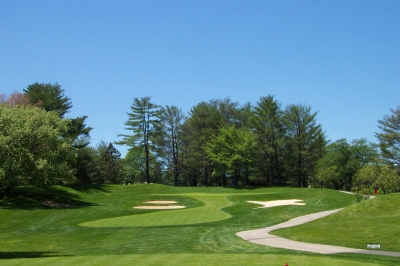 |
| The par three 7th hole is the easiest on the front nine. It offers a very long green, so choose your club wisely. |
Who will win at Congressional? That’s anybody’s guess. You’d have to be nuts not to take a serious look at Ernie Els, who takes not only fond memories of his triumph on the Blue Course in 1997, but also the confidence of several world-wide wins already in 2005.
Jones believes the green contours at Congressional will separate the better players, and it won’t just be a long-ball hitters’ golf course. He says they’ll need to get the ball in the hole and manage their shots into the greens to have a chance to win.
Regardless of who leaves with the trophy, the golf fans in the Washington area are definitely winners in 2005. As someone who’s been fortunate enough to have played both of Congressional’s golf courses, it’s easy to claim they’re once-in-a-lifetime experiences. Lucky for us, we’ll get to see the professionals give the Blue Course a try this year – and the memories are ours to keep.
The Golfer behind Booz Allen Hamilton
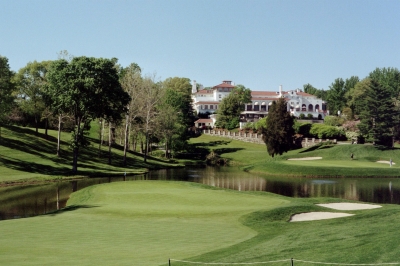 |
| The beautiful 17th hole will one day be Congressional Blue's finishing link. It's the bane of Tom Lehman, and numerous Congressional members on a daily basis. |
(Note: This bit on Dr. Ralph Shrader ran last year, but is equally relevant this year. Dr. Shrader’s enthusiasm is a key element in the success of this year’s event, and it’s important to get to know him a little better. One man can make a difference.)
In talking with Ralph Shrader, his passion for the ‘new’ golf event is clearly evident, and his sincerity to assist in charitable fundraising is also obvious.
What lies closely below the surface, however, is his love for the game of golf itself. Though hardly a strong motivating factor in steering Booz Allen towards sponsoring the Washington DC PGA Tour event, his interests in golf may have helped point him in that direction.
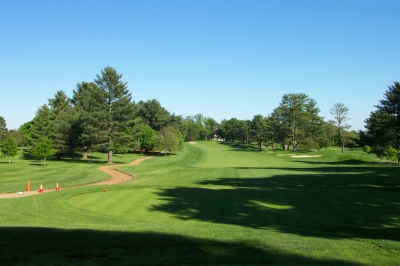 |
| Congressional's par fours are brutal -- here, the 455-yard, uphill par four 3rd hole. |
Shrader describes himself as a golf ‘enthusiast,’ having taken up the game eight years ago – mainly because his colleagues thought he should. Like all of us, he particularly enjoys the camaraderie between players during a round.
“We’ve built a lot of things at Booz Allen around the whole idea of golf,” Shrader said. “And when the opportunity to sponsor this event presented itself, it was comfortable because we had a great familiarity and understanding of the game. Golf created an atmosphere and environment where we were receptive to the idea.”
He continues, “I’ve had a lot of fun, and I’ve learned a lot from playing golf. I’ve been fascinated by how much you can learn about people when you play in the same foursome – not only what they say, but what they do and how they act – it’s a great window into really understanding someone.”
For Shrader, golf’s brought people together, having participated in group golf trips to Ireland and Scotland – and all the other activities involved in such ventures, the dinners, bus rides to the next course, the friendships made and fostered. Golf’s the central point for a lot of what life’s about, a magnet that draws people together.
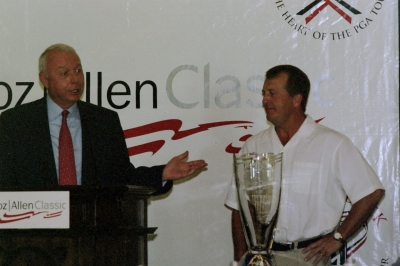 |
| Booz Allen Hamilton CEO Dr. Ralph Shrader introduces Fred Funk on Media Day, May 9th. Shrader's passion for golf is clear in his company's sponsorship, but he's also been known to push the ball around himself. |
That ‘intangible’ quality is perhaps the hardest thing for non-golfers to understand, and Shrader himself admits back in the days before he started playing, he didn’t get it either. “Coming to golf late in life, I’m fascinated by the way I used to watch these great players and wonder why they sometimes came up short. You wonder, ‘what’s wrong with those guys?’, then, when you start playing, you understand and develop a much better appreciation for how challenging this game is on so many levels, and that anything can happen.”
And many of golf’s mysteries continue to elude him, much to his frustration… and delight. “Another thing I’ve learned from golf, and have been totally frustrated by – it’s the only sport, and I’ve been very active in sports my whole life… it’s the only sport I’ve seen where, just because you practice, you don’t necessarily get better.”
“Playing golf is a frustrating and humbling experience. I can’t just relentlessly practice and know that tomorrow I’m going to be better than I was today,” Shrader chuckled.
That says a lot for a man who’s reached the heights of success on many different levels, and at many different endeavors. It also says something about golf itself – the game doesn’t care who you are, it’s just as cruel to all of us.
And we’re better for it.
Details:
2005 Booz Allen Classic
Congressional Country Club
Congressional Country Club (Blue Course)
Course Designers: Devereux Emmet, Robert Trent Jones, Rees Jones
Director of Golf: John Lyberger
Director of Golf Course Maintenance: Mike Giuffre
*Editor’s Note: Congressional Country Club is a private club – play for members and their guests only.
Tees/Yardage/Slope/Rating (Par 72; Ladies par is 74)
Blue 7250/142 75.4
Gold 6730/135 73.2
White 6195/131/134 (L) 70.6/77.1 (L)
Red 5935/126/129 (L) 69.2/76.1 (L)
| Related Links | Comments on this article? | |
|
Maryland National Golf Club Hollow Creek Golf Club Rocky Gap Resort PB Dye Golf Club in Ijamsville Whiskey Creek Golf Club |
E-mail Jeff Rendall, Editor: jrendall@golftheunitedstates.com |












